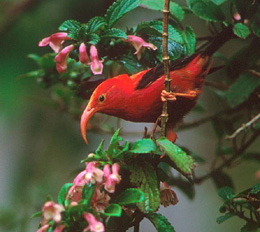Drepanidini facts for kids
Quick facts for kids Drepanidini |
|
|---|---|
 |
|
| Drepanis coccinea | |
| Scientific classification |
|
| Kingdom: | Animalia |
| Phylum: | Chordata |
| Class: | Aves |
| Order: | Passeriformes |
| Family: | Fringillidae |
| Subfamily: | Carduelinae |
| Tribe: | Drepanidini |
| Genera | |
|
See text |
|
The Drepanidini are a special group of birds known as Hawaiian honeycreepers. They are a "tribe" in the animal kingdom, which is a way scientists group similar living things together. These birds are famous for their amazing variety, especially their different beak shapes, which helped them eat different kinds of food found only in Hawaii. Sadly, many of these unique birds are now extinct.
Contents
Meet the Hawaiian Honeycreepers: Genera and Species
Scientists group living things into categories like "genus" and "species." A genus is a group of very similar species. A species is a specific type of animal that can have babies together. The Hawaiian honeycreepers include many different genera, each with its own special features.
Birds with Unique Beaks
- Genus Aidemedia: These birds had straight, thin beaks, perfect for catching insects. All species in this group are prehistoric, meaning they lived a very long time ago and are now extinct.
- Genus Akialoa: Akialoa birds had long, curved beaks. They used them to eat insects or drink nectar from flowers. Many of these species, like the Kauaʻi ʻakialoa, are now extinct.
- Genus Chloridops: These birds had very thick beaks. They were specialists at cracking open hard seeds, like those from the Myoporum sandwicense tree. The Kona grosbeak is an example of an extinct bird from this group.
- Genus Ciridops: These birds looked a bit like finches and ate the fruit of Pritchardia palm trees. The ʻula-ʻai-hāwane is an extinct species from this genus.
- Genus Drepanis: These honeycreepers had long, downward-curved beaks, perfect for sipping nectar from flowers. The ʻiʻiwi is a beautiful red bird from this group that is still alive today. Other species, like the Hawaiʻi mamo, are extinct.
- Genus Dysmorodrepanis: This group had a unique pincer-like beak, which might have helped them eat snails. The Lānaʻi hookbill is an extinct species from this genus.
- Genus Hemignathus: These birds had beaks that were either pointed or long and curved downwards. They mostly ate insects. The ʻakiapolaʻau is a living example, known for its two-part beak used to dig for bugs in wood. Many others, like the Oʻahu nukupuʻu, are extinct.
- Genus Loxioides: These finch-like birds were experts at eating seeds from certain plants, especially those in the pea family. The palila is a well-known species that still exists.
- Genus Loxops: These small birds had pointed beaks with tips that crossed slightly. They were insect eaters. Examples include the ‘akeke‘e and the Hawaiʻi ʻakepa, both still found today. Several species, like the Maui ʻakepa, are extinct.
- Genus Melamprosops: This genus had a short, pointed beak and was known to eat insects and snails. The poʻouli is a species from this group that is possibly extinct.
- Genus Orthiospiza: This prehistoric bird had a large, weak beak, which might have been used for eating soft seeds or fruits.
- Genus Palmeria: These birds had thin beaks and drank nectar, especially from the Metrosideros polymorpha tree. The ʻākohekohe is a living species in this group.
- Genus Pseudonestor: This bird had a parrot-like beak, which it used to probe wood for insect larvae. The Maui parrotbill (or kiwikiu) is the only living species in this genus.
- Genus Psittirostra: This bird had a slightly hooked beak and specialized in eating the fruit of the Freycinetia arborea plant. The ʻōʻū is a species from this group that is probably extinct.
- Genus Rhodacanthis: These birds had large beaks and ate seeds, especially from legume plants. All species in this group, like the greater koa-finch, are extinct or prehistoric.
- Genus Telespiza: These finch-like birds ate seeds and were also known to be scavengers, meaning they would eat whatever food they could find. The Laysan finch and Nihoa finch are examples of living species.
- Genus Vangulifer: These prehistoric birds had flat, rounded beaks, possibly used for catching flying insects.
- Genus Xestospiza: These prehistoric birds had cone-shaped beaks and likely ate insects.
Other Notable Genera
- Genus Chlorodrepanis: These birds had pointed beaks and ate both insects and nectar. The Hawaiʻi ʻamakihi is a common example.
- Genus Himatione: These birds had thin beaks and drank nectar. The ʻapapane is a very common and beautiful red bird from this group. The Laysan honeycreeper is an extinct species.
- Genus Magumma: These small birds had pointed beaks and ate insects and nectar. The ʻanianiau is a living species.
- Genus Oreomystis: These birds had short, pointed beaks and ate insects. The ʻakikiki is a species from this group.
- Genus Paroreomyza: These birds had short, pointed beaks and ate insects. The Maui ‘alauahio is a living species, while the kākāwahie is extinct.
- Genus Viridonia: The greater ʻamakihi from this genus is now extinct.
Many of these amazing Hawaiian honeycreepers have sadly disappeared forever. This is often due to habitat loss, new diseases, and introduced animals like rats and cats. Protecting the remaining species is very important!
See also
 In Spanish: Carduelinae para niños
In Spanish: Carduelinae para niños

